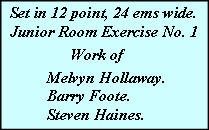|
PRINTING DEPARTMENT—INVESTMENT
DURING THE early part of 1966 a Committee was formed to study the equipment then in use in the Printing Department at Goldings.
The Committee was constituted as follows:
Professor Sir Alan Moncrieff, Mr. R. L. S. Harrison, J.P., Mr. L. Viney, together with the Headmaster and Mr. Stackwood.
Later Mr. E. F. Andrews, J.P. (National Graphical Association) and Mr. A. Stockwell, Lecturer at London College of Printing, were
invited to attend as advisers.
The outcome of two meetings was a strong recommendation from this Committee to our Headquarters that considerable expenditure
was necessary to raise the efficiency of the Department and also that additional instructors be engaged.
Permission to spend initially a sum of £7,000 on machinery and equipment was granted, as was permission to appoint two additional
instructors.
The composing room now has a new look, being re-furnished with metal units of modern design, and certain precision equipment
has been introduced to aid better composition, particularly of multi-colour jobs.
In the machine room two automatic presses have been installed; one a German machine capable of 5,000 impressions per hour on
sheet-size of 20" x 30", the other a small automatic platen of a similar output on paper of 10" x 15". A lining-up table, a precision
make-up instrument of Swiss manufacture, is also installed within this section.
Apprentices and staff are very appreciative of these additions and are putting them to good use.
A sincere thank you to our Committee for their help and to Headquarters for financing these improvements. It is hoped that the
Committee will meet shortly to discuss the next phase of re-equipment.
R. STACKWOOD
Goldonian 1966
|








